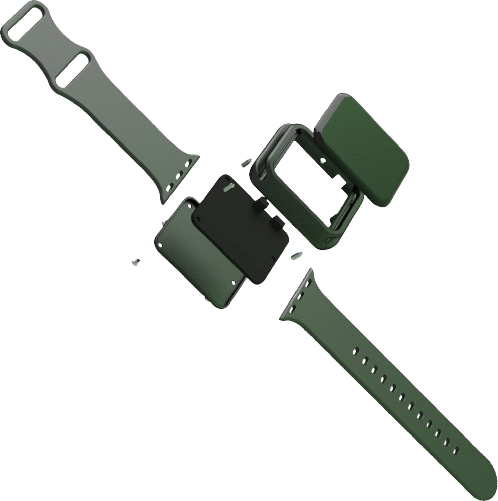We want to bring your ideas to life
CATALOG OF
PROTOTYPES
You can now access over 30 examples of prototypes designed and manufactured in our lab

Human beings have been on Earth for approximately two and a half million years: from the Paleolithic period, during which primitive man manufactured rudimentary stone tools, up to the first appearance of homo sapiens around 350,000 years ago.
We want to bring your ideas to life
You can now access over 30 examples of prototypes designed and manufactured in our lab

From then until today, the human species has evolved in unprecedented fashion, thanks to humans’ mental abilities that allow them to invent, imagine, learn and convey even abstract knowledge, and interact intelligently. Not all humans, that's true, but most.
And it is precisely this capacity to imagine, conceive and invent that has made possible the existence of crops, means of transportation, healthcare, the Internet, art and the conquest of space.
But has everything already been invented, or is there still room for imagination?
Not everything has been invented. In fact, every year some 7 million ideas are registered worldwide between patents, utility models and industrial designs. Indeed, there is feverish inventive activity throughout the world that explains, in large part, the development of societies and their economic growth. Specifically, in 2019, 6.9 million were registered according to the World Intellectual Property Organization (WIPO), 2020 edition.
But of all the inventions developed by human beings, which have changed the world in a disruptive way? Who were the inventors? The truth is that the list is huge, so we are going to highlight the most important ones, starting with the top 5.
elementor-template id=»14787″]
 Can you imagine a world without wheels? Today that’s unthinkable because it is an intrinsic part of our lives, from the moment we play with our first toy car, train or truck and observe how, almost as if by magic, it moves quickly and effortlessly. But it did not always exist. Someone – it is not known who for sure, but it must have been around 3500 BC – observed that a circular component attached to an axle made life much easier and eliminated unnecessary effort. That is, human beings have spent more than 98% of their existence without the wheel, so this invention was a key starting point for evolution. Not surprisingly, the wheel served as the basis for the construction of other more complex inventions such as carts or machines, thus clearing the way for agriculture, transportation, commerce and industry.
Can you imagine a world without wheels? Today that’s unthinkable because it is an intrinsic part of our lives, from the moment we play with our first toy car, train or truck and observe how, almost as if by magic, it moves quickly and effortlessly. But it did not always exist. Someone – it is not known who for sure, but it must have been around 3500 BC – observed that a circular component attached to an axle made life much easier and eliminated unnecessary effort. That is, human beings have spent more than 98% of their existence without the wheel, so this invention was a key starting point for evolution. Not surprisingly, the wheel served as the basis for the construction of other more complex inventions such as carts or machines, thus clearing the way for agriculture, transportation, commerce and industry.

Although it has now fallen into relative disuse due to the introduction of more modern and precise systems such as GPS, the compass was a milestone for guiding navigators on the open seas. Invented sometime around the second century BC in China, it was not until around the year 1040 AD that it was observed that a magnetized needle in a container filled with water pointed in a fixed direction, magnetic north. A few years later and after some improvements, it began to be used as a navigational instrument on the open seas, especially in the daytime or during nights with cloud cover. Today it is mainly used as a backup instrument on boats and ships and as a navigational hiking aid, thanks to its small size and weight and because it does not require batteries.

The cultural revolution in Europe and the rest of the world owes a major debt to Johannes Gutenberg of Germany, who, around the year 1450 and after multiple attempts and with outside funding, successfully designed and built the first printing press to incorporate movable type and mechanized inking. This invention replaced the painstaking writing and copying of books by hand, as it could replicate a piece of writing on a large scale, printing several copies of a text in less time than it took to do so by hand, but with the same quality. To give you an idea of the enormous impact of this invention, between 1400 and 1450 – just before the appearance of the movable type printing press – twenty thousand books were copied by hand throughout Europe, while in the following 50 years almost 20 million were printed.

Basically, a lightbulb consists of a device that turns electricity into artificial light by means of an incandescent filament, which heats up when electricity flows through it. To prevent it from burning by oxidation, the filament is enclosed inside a glass bulb containing a vacuum or an inert gas. Although the technology was developed by several inventors, Thomas A. Edison patented the first commercially successful lightbulb and deserves credit for getting it out of the laboratory and into the home. Seventy years earlier, Humphry Davy had invented the electric arc lamp, but it burnt out quickly and was too bright for home use. Thirty years later, Warren de la Rue achieved continuous incandescence, although at an impractical price. Still another thirty-five years later, the duo of Henry Woodward and Matthew Evans succeeded in improving de la Rue’s lightbulb and patented it in Canada. Finally, in 1879, Thomas Edison bought the patent for the incandescent lightbulb from Woodward and Evans, extended its life to 40 hours, and proceeded to successfully merchandise it.

The dizzying progress of Europe and the United States since the first industrial revolution of the early nineteenth century is due, in large part, to the invention of the steam engine and its prior development throughout the seventeenth and eighteenth centuries. What began as some rudimentary first attempts to pump water in mines, was transformed and developed until it became an actual device that could perform heavy work. Patented by Thomas Watt as the first steam engine and marketed as of 1775 by the company Boulton & Watt, it was used to power factories, mills and transportation by sea and land. The machine works on the principle of converting water into steam by means of a heat source (fossil fuels, solar, nuclear, etc.), which powers the engine thanks to its high pressure and temperature, while releasing steam at a lower pressure and temperature. This difference in energy input and output is transformed into mechanical work.
While there is no doubt as to the importance of these five inventions and their influence on the future of the human race, this is just an introduction. There are many more than five major inventions that have impacted the course of humanity, and we will post them as we collect them.
The time to bring your ideas to life is now. We accompany you throughout the entire process: from idea to product.
San Juan Ingenieros, S. L, is the owner of the domain www.letsprototype.com, and in accordance with the General Data Protection Regulation (EU 1679/2016), we will process your data exclusively to handle your information request. You have the right to rectify or request the deletion of your data at any time via hello@letsprototype.com.